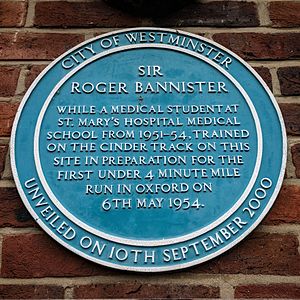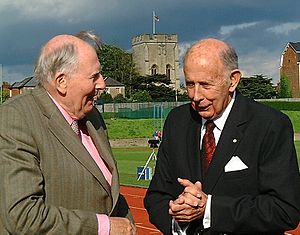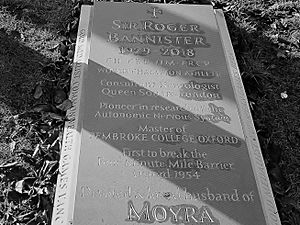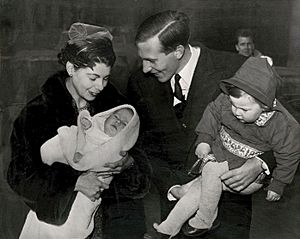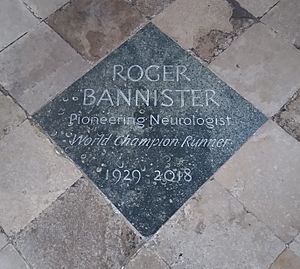Roger Bannister facts for kids
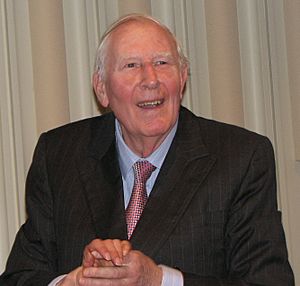
Bannister in 2009
|
|||||||||||||||||||||||
| Personal information | |||||||||||||||||||||||
|---|---|---|---|---|---|---|---|---|---|---|---|---|---|---|---|---|---|---|---|---|---|---|---|
| Full name | Roger Gilbert Bannister | ||||||||||||||||||||||
| Born | 23 March 1929 Harrow, England |
||||||||||||||||||||||
| Died | 3 March 2018 (aged 88) Oxford, England |
||||||||||||||||||||||
| Resting place | Wolvercote Cemetery, Oxford, England | ||||||||||||||||||||||
| Education | Exeter College, Oxford | ||||||||||||||||||||||
| Height | 187 cm | ||||||||||||||||||||||
| Weight | 70 kg | ||||||||||||||||||||||
| Master of Pembroke College, Oxford | |||||||||||||||||||||||
| In office 1985–1993 |
|||||||||||||||||||||||
| Preceded by | Geoffrey Arthur | ||||||||||||||||||||||
| Succeeded by | Robert Stevens | ||||||||||||||||||||||
| Sport | |||||||||||||||||||||||
| Country | |||||||||||||||||||||||
| Sport | |||||||||||||||||||||||
| Event(s) | |||||||||||||||||||||||
| Achievements and titles | |||||||||||||||||||||||
| Personal best(s) | |||||||||||||||||||||||
|
Medal record
|
|||||||||||||||||||||||
Sir Roger Gilbert Bannister (born March 23, 1929 – died March 3, 2018) was an English doctor who specialized in the brain and nervous system (a neurologist). He was also a middle-distance runner. He became famous for being the first person to run a mile in under four minutes.
At the 1952 Summer Olympics in Helsinki, Roger Bannister set a new British record in the 1500 metres race. He finished in fourth place. This made him even more determined to be the first athlete to run a mile in less than four minutes. He achieved this amazing goal on May 6, 1954, at the Iffley Road track in Oxford. His friends, Chris Chataway and Chris Brasher, helped him by setting the pace. When the announcer, Norris McWhirter, started to say his time, the crowd cheered so loudly that they drowned out the exact numbers. His time was 3 minutes and 59.4 seconds. He managed this record with very little training, as he was also working as a junior doctor. Bannister's record was broken just 46 days later.
After his running career, Bannister became a neurologist and later led Pembroke College, Oxford as its Master. He retired in 1993. When asked if the 4-minute mile was his greatest achievement, he said he was prouder of his work in medicine, especially his research into the nervous system. Bannister supported the MSA Trust. He was diagnosed with Parkinson's disease in 2011.
Contents
Early Life and School Days
Roger Bannister was born on March 23, 1929, in Harrow, London. His parents, Ralph and Alice, came from working-class families in Lancashire. His father, Ralph, moved to London at age 15 to work for the government. He met Alice when he visited home. They got married in 1925 and had a daughter, Joyce, before Roger was born.
Soon after World War II began, his family moved to Bath because his father was moved there for work. Roger continued his education at City of Bath Boys' School. There, he discovered he was good at cross country running. He won the junior cross-country cup three times in a row, which earned him a small trophy.
During a bombing raid on Bath, the Bannisters' house was badly damaged while they were safe in the basement.
In 1944, the family returned to London, and Roger went to University College School. Bannister was accepted into St John's College, Cambridge, but was advised to wait a year. After that year, he applied to Exeter College, Oxford and was accepted to study medicine for three years.
Roger Bannister's Running Career
Starting His Running Journey
Bannister was inspired by another runner, Sydney Wooderson, in 1945. Wooderson had set a mile record years before, but Swedish runners had broken it during the war. Wooderson tried to get his record back.
Like Wooderson, Bannister would also set a mile record, see it broken, and then run a new personal best that was slower than the new record.
Bannister began running at Oxford in the autumn of 1946 when he was 17. He had never worn special running shoes or run on a track before. He trained very little, even for that time. Still, he showed promise by running a mile in 4 minutes and 24.6 seconds in 1947, training only three times a week for half an hour.
He was considered for the 1948 Summer Olympics but decided he wasn't ready. However, watching those Olympics made him even more determined to become a great miler. He then set his sights on the 1952 Summer Olympics in Helsinki.
In 1949, he got better at the 880-yard (805-meter) run, finishing in 1 minute and 52.7 seconds. He also won several mile races in about 4 minutes and 11 seconds.
In 1950, he improved even more. He finished an 800-meter race at the European Championships in 1 minute and 50.7 seconds, placing third. After this, Bannister started to train harder.
His harder training quickly paid off. He won a mile race in 4 minutes and 9.9 seconds in December. Then, in 1951, at the Penn Relays, Bannister ran the last lap very fast, finishing in 4 minutes and 8.3 seconds. In his biggest test yet, he won a mile race on July 14 in 4 minutes and 7.8 seconds at the AAA Championships. He beat the defending champion, Bill Nankeville.
However, Bannister lost a 1500-meter race in Belgrade to Andrija Otenhajmer from Yugoslavia. Otenhajmer ran very fast from the start, forcing Bannister to try and catch up. Otenhajmer won, but Bannister still set a personal best of 3 minutes and 48.4 seconds, finishing second. People no longer saw Bannister as unbeatable.
His training methods were quite modern. He used a mix of interval training with ideas from his coach Franz Stampfl. He also included fell running and other intense exercises.
From 1951 to 1954, Bannister trained at the track at Paddington Recreation Ground in Maida Vale. This was while he was a medical student at the nearby St Mary's Hospital. There are two plaques for Bannister at the pavilion, which he himself revealed in 2000. One is a round blue plaque, and the other is a rectangular historic plaque with more details. The historic plaque says that Bannister could only train for about an hour each day because of his medical studies.
The 1952 Olympics Experience
Bannister did not race much after the 1951 season. He saved his energy for the 1952 Olympics in Helsinki. He ran an 880-yard (805-meter) race in 1 minute and 53 seconds in May 1952. Then, he did a mile time-trial in 4 minutes and 10.6 seconds in June, feeling good about his results. At the AAA championships, he skipped the mile and won the 880-yard race in 1 minute and 51.5 seconds. Ten days before the Olympic final, he ran a 3/4 mile time trial in 2 minutes and 52.9 seconds. He felt confident that this time meant he was ready for the Olympics.
However, his confidence soon disappeared. It was announced that there would be semi-finals for the 1500-meter race at the Olympics. He felt this would favor runners who trained much more than he did. When he ran his semi-final, Bannister finished fifth, which qualified him for the final. But he felt "blown and unhappy."
The 1500-meter final on July 26, 1952, was very exciting. The race was decided only in the last few meters. Josy Barthel from Luxembourg won in an Olympic record time of 3 minutes and 45.28 seconds. The next seven runners also finished faster than the old record. Bannister finished fourth, just missing a medal. However, he set a new British record of 3 minutes and 46.30 seconds.
A New Goal: The Four-Minute Mile
After not winning a medal at the 1952 Olympics, Bannister spent two months thinking about whether to stop running. He then set a new goal: to be the first person to run a mile in under four minutes. To achieve this, he trained harder and did intense interval training.
On May 2, 1953, he tried to break the British record in Oxford. With Chris Chataway setting the pace, Bannister ran 4 minutes and 3.6 seconds. This easily broke Wooderson's record from 1945. Bannister later said, "This race made me realize that the four-minute mile was not out of reach."
On June 27, 1953, a mile race was added to a school athletics meeting. Australian runner Don Macmillan set a fast pace for the first two laps. He then stopped, but Chris Brasher took over. Brasher had jogged the race earlier, allowing Bannister to pass him so he could be a fresh pace-setter. At three-quarters of a mile, Bannister was at 3 minutes and 1.8 seconds. The record, and the first sub-four-minute mile, seemed possible. But he couldn't quite do it, finishing in 4 minutes and 2.0 seconds. This time was only beaten by two other runners, Andersson and Hägg. British officials did not allow this to be a British record, which Bannister later felt was a good decision.
Other runners were also trying to break the four-minute barrier. American Wes Santee ran 4 minutes and 2.4 seconds in June 1953. At the end of that year, Australian John Landy ran 4 minutes and 2.0 seconds.
In early 1954, Landy made more attempts. He ran 4 minutes and 2.4 seconds in Melbourne in January, and then 4 minutes and 2.6 seconds twice in February and April.
Bannister had been watching Landy's attempts and was sure his Australian rival would succeed soon. But knowing that Landy's last attempt of the season was in April, Bannister realized he had to make his own attempt very soon.
The First Sub-4-Minute Mile
This historic event happened on May 6, 1954. It was during a sports meet between the British AAA and Oxford University at Iffley Road Track in Oxford. About 3,000 people watched. The winds were strong before the race, up to 25 miles per hour. Bannister had said twice that he didn't want to run, preferring to save his energy to break the 4-minute barrier another time. However, the winds calmed down just before the race was set to begin, and Bannister decided to run.
His friends, Christopher Chataway and Chris Brasher, who had helped him set paces in 1953, worked together to help him in this race. The race was broadcast live on BBC Radio. The commentator was Harold Abrahams, who was an Olympic champion from 1924 and famous from the movie Chariots of Fire.

Bannister started his day at a hospital in London. He sharpened his running spikes and put graphite on them so they wouldn't pick up too much cinder dust from the track. He took a train from Paddington Station to Oxford, feeling nervous about the rainy, windy weather.
There were seven runners listed for the mile race. However, one runner, Nigel Miller, arrived as a spectator and only realized he was supposed to run when he read the program. He couldn't find a running kit, so he couldn't take part, leaving six runners.
The race started at 6:00 p.m. Brasher and Bannister immediately went to the front. Brasher led the first lap in 58 seconds and the half-mile in 1 minute and 58 seconds, with Bannister right behind him. Chataway moved to the front after the second lap and kept the pace, reaching the final lap bell at 3 minutes and 1 second. Chataway continued to lead until Bannister started his final burst of speed with about 275 yards (250 meters) left. He ran the last lap in just under 59 seconds.
The announcer for the race was Norris McWhirter, who later helped create the Guinness Book of Records. He announced: "The time was three..."
The loud cheers from the crowd drowned out the rest of the announcement. Bannister's official time was 3 minutes, 59.4 seconds.
The idea that a four-minute mile was once thought to be impossible is a myth. It was created by sports writers and Bannister himself explained it wasn't true in his book, The Four Minute Mile (1955).
The reason this myth became popular was that four minutes was a nice round number. The world record had been just slightly out of reach (by only 1.4 seconds) for nine years. This was partly because World War II had stopped athletic progress in many countries. Swedish runners, Gunder Hägg and Arne Andersson, had already lowered the world mile record by five seconds before Bannister. People who know a lot about track and field are most impressed that Bannister ran a four-minute mile with very little training compared to today's standards.
Just 46 days later, on June 21, 1954, Bannister's record was broken by his rival, John Landy, in Turku, Finland. Landy ran it in 3 minutes and 57.9 seconds.
The "Miracle Mile" of 1954
On August 7, at the 1954 British Empire and Commonwealth Games in Vancouver, Bannister, running for England, raced against Landy for the first time. This race was called "The Miracle Mile." They were the only two men in the world who had run a mile in under 4 minutes, and Landy still held the world record.
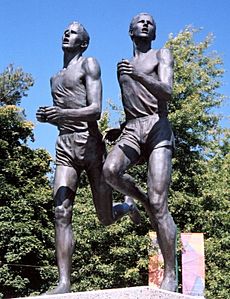
Landy led for most of the race, building a lead of 10 yards (about 9 meters) in the third lap. But Bannister caught up and passed him on the last turn. Bannister won in 3 minutes and 58.8 seconds, with Landy 0.8 seconds behind at 3 minutes and 59.6 seconds. Both Bannister and Landy said that the most important moment was when Bannister decided to pass Landy. At that exact moment, Landy looked over his left shoulder to see where Bannister was, and Bannister burst past him on the right, staying in the lead.
A large bronze statue of the two runners at this moment was made in 1967 by sculptor Jack Harman. It was based on a photo by Charlie Warner. The statue stood for many years at the entrance to Empire Stadium. After the stadium was taken down, the statue was moved to the entrance of the Pacific National Exhibition (PNE) fairgrounds. Landy joked about the statue, saying: "While Lot's wife was turned into a pillar of salt for looking back, I am probably the only one ever turned into bronze for looking back."
Later that season, Bannister won the 1500-meter race (sometimes called the "metric mile") at the European Championships in Bern, Switzerland, on August 29. He set a championship record with a time of 3 minutes and 43.8 seconds. He stopped running competitively in late 1954 to focus on his work as a junior doctor and to become a neurologist. The next year, he received an award called a CBE for his "services to amateur athletics."
Sports Council and Knighthood
Bannister later became the first leader of the Sports Council (now called Sport England). He was made a knight in 1975 for his work there. Under his leadership, the government increased funding for sports centers and facilities. He also started the first tests for the use of anabolic steroids in sports.
Roger Bannister's Medical Career
After he stopped running in 1954, Bannister spent the next forty years working as a doctor, specializing in neurology. In March 1957, he joined the Royal Army Medical Corps and served for two years as a lieutenant.
His main contribution to medicine was in the area of autonomic failure. This is a part of neurology that studies illnesses where the nervous system loses some of its automatic responses, like how your heart rate goes up when you stand. He wrote more than eighty papers, mostly about the autonomic nervous system, heart and blood vessel function, and multiple system atrophy. He also edited a textbook called Autonomic Failure and five editions of Brain and Bannister's Clinical Neurology.
Bannister always said he was prouder of his work in medicine than his running career. In 2014, he said in an interview: "I'd rather be remembered for my work in neurology than my running. If you offered me the chance to make a great breakthrough in the study of the autonomic nerve system, I'd take that over the four minute mile right away. I worked in medicine for sixty years. I ran for about eight."
Roger Bannister's Family Life
In 1955, Bannister married Moyra Elver Jacobsson, a Swedish artist, in Basel, Switzerland. Moyra's father was Per Jacobsson, a Swedish economist who led the International Monetary Fund.
They had four children: Carol (born 1957), Clive (born 1959), Thurstan (born 1960), and Charlotte (born 1963). Charlotte is now a priest in Oxford.
In 2011, Bannister was diagnosed with Parkinson's disease. He passed away on March 3, 2018, in Oxford, at the age of 88. He is buried in Wolvercote Cemetery near Oxford. His wife, Lady Moyra Bannister, died in Oxford in November 2022, at age 94.
Roger Bannister's Legacy
On the 50th anniversary of his sub-4-minute mile, Bannister was interviewed by the BBC. He was asked if the 4-minute mile was his most important achievement. Bannister replied that he felt his forty years of practicing medicine and the new procedures he introduced were more important. He also said that, in terms of sports, his performances at the 1952 Olympics and the 1954 Commonwealth Games were more significant than the 4-minute mile.
It's interesting that even though Roger Bannister is perhaps the most famous person to set a mile record, he also held the record for the shortest time. This is true at least since the IAAF started officially recognizing records.
Media and Recognition
For his achievements, Bannister was the first person to receive the Sports Illustrated Sportsperson of the Year award in 1954. He is one of the few non-Americans to be recognized by this American magazine.
In a UK poll by Channel 4 in 2002, the British public voted Bannister's historic sub-4-minute mile as number 13 on the list of the 100 Greatest Sporting Moments.
Bannister is the subject of the ESPN film Four Minutes (2005). This movie is a dramatization, meaning it changes some facts. For example, it creates a fictional coach for Bannister, when his real coach was Franz Stampfl. Also, it shows him meeting his wife, Moyra Jacobsson, in the early 1950s, but they actually met in London only a few months before the "Miracle Mile."
Bannister: Everest on the Track, The Roger Bannister Story is a 2016 TV documentary. It covers his childhood during World War II and his breaking of the 4-minute mile. It includes interviews with people who were there and later runners inspired by Bannister, like Phil Knight, who says Roger Bannister inspired him to start Nike.
In the 1988 TV mini-series The Four Minute Mile, which was about the race between Bannister, John Landy, and Wes Santee to break the 4-minute mile, Bannister was played by actor Richard Huw.
Places Named After Roger Bannister
In 1996, Pembroke College at the University of Oxford (where Bannister was Master for eight years) named a building after him. The Bannister Building was an 18th-century house changed to provide housing for graduate students. After renovations in 2011 and 2012, it became part of a larger building complex and is now used for undergraduate student housing.
In March 2004, St Mary's Hospital Medical School named a lecture theater after Bannister. On display there is the stopwatch used to time his famous race, stopped at 3:59. Bannister also gave his name to the trophy given to the winning team in the yearly athletics competition between medical schools in London. He also bought the cup for the winning team in the annual United Hospitals Cross-Country Championship.
In 2012, Bannister carried the Olympic flame at the Oxford University track stadium, which is now named after him.
On September 28, 2021, a memorial stone honoring Sir Roger, described as a "pioneering neurologist, world champion runner," was revealed in Westminster Abbey. It is in an area known as 'Scientists' corner'.
Memorabilia
The 50th anniversary of Bannister's achievement was celebrated with a special British 50-pence coin. The back of the coin shows a runner's legs and a stopwatch (stopped at 3:59.4). Over 9 million of these coins were made. The coin was made again for collector sets in 2019 as part of the Royal Mint's '50 Years of the 50p coin' collection.
In the dining hall of Pembroke College, there is a display cabinet with over 80 items related to Bannister's athletic career and some of his academic achievements.
Awards and Honors
Bannister received many honors for his achievements in sports and medicine. He was made a knight in 1975. In 2017, he was appointed a Member of the Order of the Companions of Honour (CH) for his services to sport.
Bannister was an Honorary Fellow of Exeter College and Merton College, where he studied at the University of Oxford. He also received honorary degrees (Doctor of Science) from the University of Sheffield in 1978 and from the University of Bath in 1984. He also received honorary degrees from the University of Pavia in 1986, from Brunel University London in 2008, and from Oxford Brookes University in 2014. In 2000, Bannister received the Golden Plate Award from the American Academy of Achievement.
Bannister was made an Honorary Freeman of the London Borough of Harrow in May 2004. He was also given the Freedom of the City of Oxford in 2004.
Selected Publications
Autobiographies
- Bannister, Roger. The Four Minute Mile. Dodd, Mead, 1955.
- Bannister, Roger. First Four Minutes. Putnam, 1955.
- Bannister, Roger. Twin Tracks: The Autobiography. The Robson Press, 2014.
Academic Books
- Bannister, R., and Mathias, C. J. (editors). Autonomic failure : a textbook of clinical disorders of the autonomic nervous system. 4th ed. Oxford University Press, 1999.
- Bannister, Roger, and Brain, Walter Russell. Brain and Bannister's clinical neurology. 7th ed. Oxford University Press, 1992.
Other Media Appearances
In 2014, he was a guest on BBC Radio 4's Midweek show.
See also
 In Spanish: Roger Bannister para niños
In Spanish: Roger Bannister para niños


